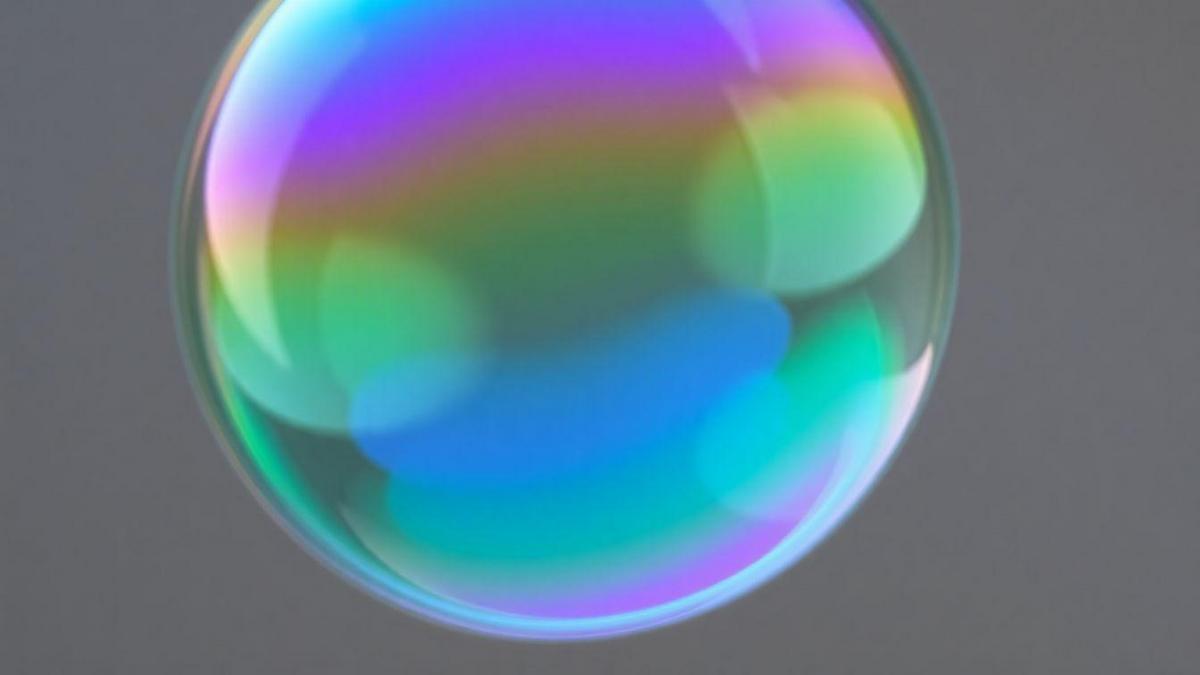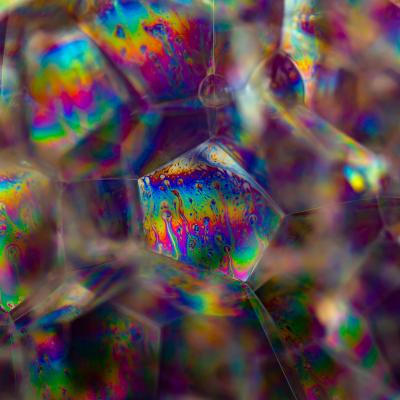Anúncios
The soap bubbles enchant by the beauty and complexity they reveal, uniting physics and mathematics in a simple phenomenon. Their formation involves the interaction between thin liquid films and surface tension that shapes the trapped air. These delicate spheres display iridescent colors that fascinate and can be scientifically explained.
Understanding the mathematics behind soap bubbles is not just a theoretical exercise, but a gateway to various practical applications. From advances in materials science to educational processes, the study of these structures brings multiple advantages. Exploring them reveals the link between science, art, and technology.
Anúncios

How do soap bubbles form and behave?
Soap bubbles are fascinating structures that arise from the interaction between physics and mathematics. They consist of thin liquid films that trap air, forming a delicate sphere that reflects and refracts light. The formation of a soap bubble begins when soap is mixed with water, creating a solution that reduces the surface tension of the water. This reduction allows the water molecules to spread and form a film. When air is introduced into this film, it expands into a bubble shape, while surface tension tries to minimize the surface area of the liquid.
The behavior of soap bubbles is governed by several physical principles, including the balance of forces acting on the bubble’s surface. Surface tension pulls the liquid film inward, while the pressure of the trapped air pushes outward. This balance results in the spherical shape we associate with bubbles, since a sphere has the smallest surface area for a given volume. Moreover, soap bubbles can merge and split, creating complex shapes and patterns, and their iridescent colors result from light interference, a mathematical phenomenon that can be analyzed and understood through geometry and wave theory.
Advantages of understanding the mathematics behind soap bubbles and iridescent colors
Understanding the mathematics behind soap bubbles and their iridescent colors offers numerous advantages in various fields, including physics, engineering, and even art. One of the main benefits is the enhancement of our knowledge about fluid dynamics. By studying the behavior of soap bubbles, scientists can gain insights into how fluids behave under different conditions, which can be applied to a variety of real-world scenarios, from industrial processes to environmental sciences.
Additionally, the study of soap bubbles can lead to advances in materials science. By understanding the properties of soap films, researchers can develop new materials with unique characteristics, such as greater strength or flexibility. This knowledge can be particularly useful in designing lightweight structures or developing new coatings and protective films. Furthermore, the mathematical models used to describe soap bubbles can be applied to other areas of study, such as the behavior of foams and emulsions, essential in food sciences, cosmetics, and pharmaceuticals.
Another advantage of exploring the mathematics of soap bubbles is their educational value. Studying bubbles offers a tangible way to engage students with complex mathematical concepts such as geometry, calculus, and wave theory. By observing the colorful patterns and shapes of soap bubbles, students can develop a deeper appreciation for the beauty of mathematics and its applications in the natural world. This engagement can inspire future generations of scientists, mathematicians, and engineers to pursue careers in STEM fields.
Finally, understanding the mathematics behind soap bubbles can increase our appreciation for the aesthetic qualities of these structures. The iridescent colors and intricate patterns seen in soap bubbles are not only visually striking but also serve as a reminder of the underlying mathematical principles governing their formation. By appreciating the beauty of soap bubbles through a mathematical lens, individuals can develop a greater appreciation for the interconnection between art and science.
How to explore the mathematics behind soap bubbles and iridescent colors
Exploring the mathematics behind soap bubbles and iridescent colors can be an engaging and enlightening experience. Here are some ways to delve deeper into this captivating subject:
- Understand surface tension equations: Begin by studying the fundamental equations of surface tension, which describe how forces act on liquid surfaces. This knowledge will provide a foundation to understand how soap bubbles form and behave.
- Discover geometry formulas of bubbles: Learn about the geometric properties of soap bubbles, including formulas that describe their shapes and volumes. Understanding the mathematics of spheres and other geometric figures can help you appreciate the elegance of bubble formation.
- Learn about light interference in soap bubbles: Investigate the phenomenon of light interference, which occurs when light waves reflect on the surfaces of soap films. This understanding will clarify why soap bubbles display vibrant colors and patterns.
- Explore color patterns in bubbles: Study the various color patterns that can be observed in soap bubbles and how these patterns change as the bubble evolves. This exploration may involve both qualitative observations and quantitative analyses.
- Investigate optical properties of soap films: Dive deeper into the optical properties of soap films, including how they refract and reflect light. Understanding these properties can increase your appreciation for the visual effects created by soap bubbles.
- Apply mathematical models of bubbles: Finally, apply mathematical models to simulate the behavior of soap bubbles. This might involve using software tools to create visual representations of bubble dynamics and color patterns, allowing a deeper understanding of the underlying mathematics.
By engaging in these activities, you can gain a comprehensive understanding of the mathematics behind soap bubbles and their iridescent colors, enriching your knowledge and appreciation of this fascinating subject.
The Formation and Behavior of Soap Bubbles

The creation of a bubble begins with mixing soap and water, which decreases surface tension. This reduction allows the liquid to stretch and form a film capable of containing air. By blowing, air inflates this liquid film, giving rise to the bubble.
The balance between the internal air pressure and the surface tension of the water defines the bubble’s shape. The pressure pushes outward while the tension tries to minimize the surface, creating a sphere. This geometry is the most efficient to maintain volume with the smallest outer area.
Moreover, bubbles can merge or split, forming networks and complex structures. This dynamics is a rich field for study, as it demonstrates physical and mathematical principles in continuous action. The shape and behavior of bubbles are a window to understanding natural phenomena.
The Role of Mathematics in Soap Bubbles
Mathematics helps describe the shapes and volumes of bubbles precisely. Equations modeling surface tension and force balance are essential to predict their behavior. Spherical geometry is the basis for this understanding.
Mathematical models also explain how bubbles change and interact, allowing computational simulations. This facilitates the analysis of the behavior of multiple bubbles in contact and the formation of more complex structures. Mathematics translates physical phenomena into comprehensible language.
The mathematical study of bubbles extends to other systems, such as foams and thin films. The same mathematical basis serves to understand materials and processes in diverse scientific fields. Thus, bubbles function as a simplified but powerful model.
Light Interference and Iridescent Colors

The vibrant colors of bubbles are caused by light interference in the layers of the soap film. Light reflects on different surfaces of the film and, when combined, creates colorful patterns. This phenomenon is explained by wave theory.
The variable thickness of the film alters the wavelengths that interfere constructively or destructively. This results in the dynamic changes of colors as the bubble moves and ages. Each bubble is like a canvas displaying a unique luminous spectacle.
Studying these optical effects requires understanding how light propagates and interacts with thin surfaces. This involves physics and mathematics concepts applied to optics. Thus, bubbles are practical examples of complex interference phenomena.
Did you enjoy learning about the mathematics behind soap bubbles and iridescent colors?
Learning about the mathematics behind soap bubbles and their iridescent colors opens a world of wonder and curiosity. The intricate relationship between mathematics, physics, and art is beautifully illustrated through the behavior of these delicate structures. As you explore this topic further, you will discover the deep connections that exist within the natural world.
There is much more to discover about the fascinating interaction of mathematics and soap bubbles. Whether you are a student, educator, or simply a curious individual, diving deeper into this subject can lead to a greater appreciation of the beauty of science and the elegance of mathematical principles.
Frequently Asked Questions
What makes soap bubbles round?
Soap bubbles are round because of surface tension. This tension pushes the liquid into the most stable shape, which is a sphere.
Why do soap bubbles have iridescent colors?
The iridescent colors in bubbles happen because of reflected light. Light changes as it passes through the soap film, creating these beautiful colors.
How is mathematics involved in soap bubbles?
Mathematics helps understand the shape and patterns of bubbles. Surface and tension equations show how they behave.
Can I make soap bubbles at home?
Yes! You can easily make bubbles using water, soap, and a bit of sugar or glycerin. Just mix and blow!
Are there different shapes of soap bubbles?
Yes, you can make bubbles in different shapes! But most will still be round because of surface tension.
